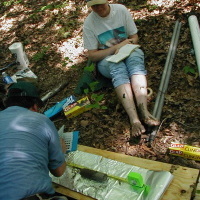Papers by Amila Sumanapala
reticulatum and invasive flora such as Clidermia hirta, Eupatorium riparium and Ludwigia peruvian... more reticulatum and invasive flora such as Clidermia hirta, Eupatorium riparium and Ludwigia peruviana were commonly found in the surveyed areas. Other main conservation issues are use of chemical fertilizers and pesticides and soil erosion. Increase of organic farming practices and habitat enrichment programs may improve the biodiversity in these plantations. Aforestation of native plant species especially butterfly host plants and fruit trees, eradication of alien invasive species, establishment of reserved forest areas are some steps that can be followed in order to achieve this.

A preliminary study on the diversity of odonata was carried out for the first time to assess the ... more A preliminary study on the diversity of odonata was carried out for the first time to assess the diversity of odonata in the Peak Wilderness Sanctuary (PWS), Sri Lanka. It is a biologically rich area surrounding the Adam's Peak which is located at 6° 48' 33.357" N and 80° 29' 58.3182" E. Total area of the sanctuary is about 24,000 ha and the altitude ranges from 50 m to 2238 m.. The study was conducted from August 2012 to August 2013. Visual encounter survey method was used for the sampling and it was carried out along the existing paths and streams in the sanctuary covering many different habitats types. Sampling was done in the day time from 0800 h to 1700 h as odonates are most active during the day. 34 species of odonates representing 11 families were recorded during the study while 30 of them were identified to the species level. This represents 28.1% (from 121 species) of the Sri Lankan odonate fauna. 19 of the recorded species (55.9%) belong to Suborder Zygoptera while the remaining 15 (44.1%) belongs to the Suborder Anisoptera. Seven of the identified species are endemic to the country while 13 species are considered to be threatened with extinction at the national level. 10 of the threatened species are known to be Vulnerable while three species are endangered. The nationally data deficient and globally critically endangered damselfly Sinhalestes orientalis (Hagen in Selys, 1862) which has not been recorded for 154 years was also observed during this study. The high species richness of odonata and the presence of many threatened species and data deficient species indicate that the PWS is an important area for the odonata thus more comprehensive studies and suitable conservation actions should be made.

Initiating proper conservation and management strategies requires assessing the consequences of f... more Initiating proper conservation and management strategies requires assessing the consequences of forest
conversion into human land use systems on tropical biodiversity. This study characterized bird species
diversity and composition and vegetation structural components in four land use types in the northern
flank of the Knuckles Mountain Forest Range, which is a part of a world heritage site in Sri Lanka: an
undisturbed forest and three human-modified land uses for cardamom, pinus, and abandoned tea
plantations. Using the fixed radius point count method, 1,023 individuals belonging to 51 bird species
were recorded. The cardamom plantation with native shade trees had a bird species richness and
composition comparable to an undisturbed forest (one-way analysis of variance; p > 0.05, Jaccard
index ¼ 0.56). Based on the ShannoneWiener index, the overall species diversity was highest in the
undisturbed forest. Pearson’s correlation coefficient suggested a strong positive linear relationship between
bird species richness with canopy cover (r ¼ 0.738) and vertical stratification (r ¼ 0.813). Land use
systems formed by considerable alterations to vegetation structure significantly reduce bird diversity and
supports a bird community that is less comparable to an undisturbed forest.
The Crested Goshawk Accipiter trivirgatus has interested birdwatchers and ornithologists on Sri L... more The Crested Goshawk Accipiter trivirgatus has interested birdwatchers and ornithologists on Sri Lanka for many years as is evident by the detailed descriptions made by prominent ornithologists such as Vincent Legge and G. M. Henry. It is a medium sized accipiter widely distributed in the Indomalayan region, and 11 subspecies have been identified. The Sri Lankan subspecies layardi has been recorded island-wide and frequents forest habitats with dense tree cover. Although much has been written about its morphology and behaviour, the small differences in the plumage of the bird reported here have not been mentioned before and together with the accompanying images may be helpful in identifying juvenile Crested Goshawk on Sri Lanka.

The Knuckles Mountain Forest Range (KMFR) has a complex mosaic of natural and human modified habi... more The Knuckles Mountain Forest Range (KMFR) has a complex mosaic of natural and human modified habitats and the contribution of these habitats to the biological and functional diversities has not been deeply studied. Present study investigated both of these diversities in five habitat types (two natural habitats: Sub-montane forest and Pitawala Patana grassland; three modified habitats: cardamom, pinus and abandoned tea plantations) in Northern Flank of KMFR using birds as the indicator group. Bird communities were surveyed using point count method. A total of 1,150 individuals belonging to 56 species were observed. The highest species richness was reported from the cardamom plantation where as sub-montane forest had the highest feeding guild diversity in terms of Shannon Weiner index. The abandoned tea plantation and the Pitawala Patana grasslands with fairly open habitats, showed relatively lower levels of feeding guild diversities. It is clear that the structurally complex habitats contribute more to the area’s biological and functional diversities and need to be taken into consideration when developing conservation plans.
Sinhalestes orientalis (Hagen in Selys, 1862) the only representative of its genus, is an endemic... more Sinhalestes orientalis (Hagen in Selys, 1862) the only representative of its genus, is an endemic and globally critically endangered damselfly in Sri Lanka. It was first collected from Rambodde, Sri Lanka in 1858 and after that no new information on this species has been available. Here, we report on the re-discovery of Sinhalestes orientalis from the Peak Wilderness Sanctuary, Sri Lanka after 154 years from its last and only record.











Uploads
Papers by Amila Sumanapala
conversion into human land use systems on tropical biodiversity. This study characterized bird species
diversity and composition and vegetation structural components in four land use types in the northern
flank of the Knuckles Mountain Forest Range, which is a part of a world heritage site in Sri Lanka: an
undisturbed forest and three human-modified land uses for cardamom, pinus, and abandoned tea
plantations. Using the fixed radius point count method, 1,023 individuals belonging to 51 bird species
were recorded. The cardamom plantation with native shade trees had a bird species richness and
composition comparable to an undisturbed forest (one-way analysis of variance; p > 0.05, Jaccard
index ¼ 0.56). Based on the ShannoneWiener index, the overall species diversity was highest in the
undisturbed forest. Pearson’s correlation coefficient suggested a strong positive linear relationship between
bird species richness with canopy cover (r ¼ 0.738) and vertical stratification (r ¼ 0.813). Land use
systems formed by considerable alterations to vegetation structure significantly reduce bird diversity and
supports a bird community that is less comparable to an undisturbed forest.
conversion into human land use systems on tropical biodiversity. This study characterized bird species
diversity and composition and vegetation structural components in four land use types in the northern
flank of the Knuckles Mountain Forest Range, which is a part of a world heritage site in Sri Lanka: an
undisturbed forest and three human-modified land uses for cardamom, pinus, and abandoned tea
plantations. Using the fixed radius point count method, 1,023 individuals belonging to 51 bird species
were recorded. The cardamom plantation with native shade trees had a bird species richness and
composition comparable to an undisturbed forest (one-way analysis of variance; p > 0.05, Jaccard
index ¼ 0.56). Based on the ShannoneWiener index, the overall species diversity was highest in the
undisturbed forest. Pearson’s correlation coefficient suggested a strong positive linear relationship between
bird species richness with canopy cover (r ¼ 0.738) and vertical stratification (r ¼ 0.813). Land use
systems formed by considerable alterations to vegetation structure significantly reduce bird diversity and
supports a bird community that is less comparable to an undisturbed forest.